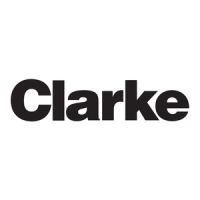Page 31 of 49
Figure #26
3.4.7.3 Setting Raw Water Flow Rate
The proper amount of raw water flow thru the engine
is of the utmost importance, and the pressure gauge
value does little to indicate if there is sufficient flow.
When the engine is exercised weekly, the amount of
raw water flow exiting the engine should always be
checked to verify it does not appear to have
diminished.
During initial commissioning of the engine, it is
important to correctly set the raw flow rate going thru
the cooling loop. Each Clarke engine model has an
Installation and Operation (I&O) Datasheet that
provides basic operating conditions of the engine and
most values are given based upon engine speed. You
will find this datasheet in the documentation bag that
is shipped with the engine for your specific Clarke
model. This datasheet must be available during
commissioning in order to set the proper minimum
raw water flow. With the fire pump flowing 150% of
rated flow, and the Automatic flow line open; verify
sufficient raw water flow rate is achieved and that the
reading of the cooling loop pressure gauge does not
exceed 60 psi (4 bar). You will need to capture the
flow for a specific amount of time coming out of the
heat exchanger and going to a floor drain in order to
establish a reasonably accurate flow rate value. Using
a container or bucket of known volume, record the
time required to fill the container and compare to the
gpm or L/min value provided on the I&O datasheet.
THIS IS CRITICAL FOR PROPER ENGINE
COOLING AT MAXIMUM PUMP LOAD!!
If proper cooling water flow rate is established then
no fire pump controller alarm will be triggered to
indicate clogged raw water strainer (low raw water
flow).
After verifying raw water flow rate in the Automatic
flowline, open the Manual by-pass line shut-off
valves, and then close the Automatic flowline shut-
off valves and repeat the above process in order to
verify the flowrate going thru the Manual by-pass
line. Note, with Automatic flowline closed the
controller low raw water flow alarm may be present ,
this is normal. Once this is completed; close the
Manual by-pass shut-off valves and open the
Automatic flowline shut-off valves to restore
conditions back to normal.
3.4.7.4 Raw Water Outlet
NOTE: NFPA 20 does allow for the heat exchanger
outlet flow to be returned to a suction reservoir. This
makes it very difficult to measure the flowrate.
When discharging to a suction reservoir, NFPA
provides additional requirements:

